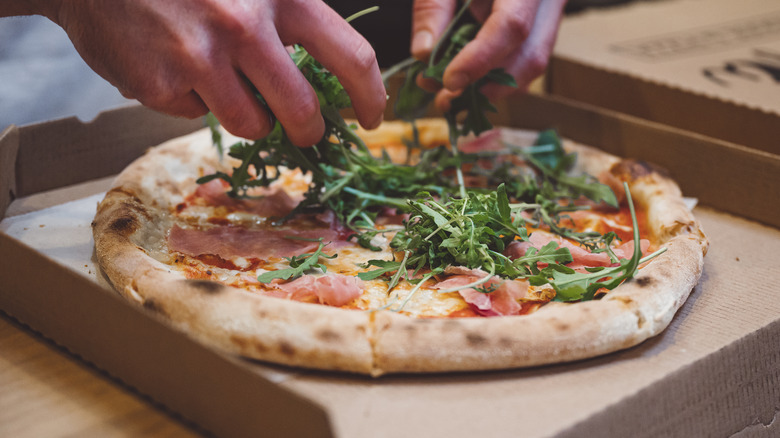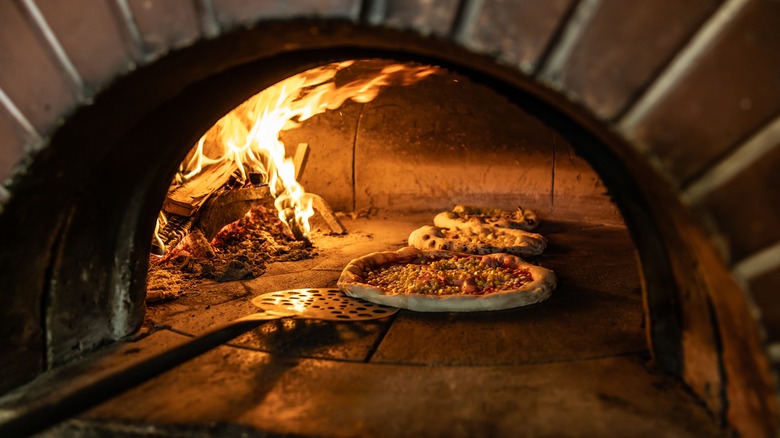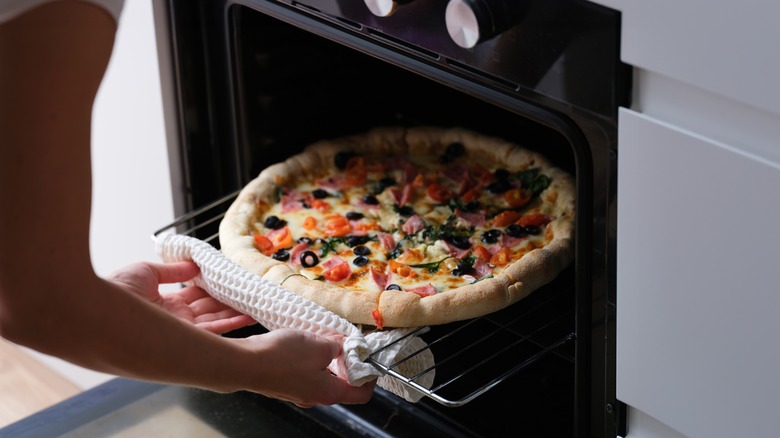The Unconventional Tool That Can Make Restaurant-Style Pizza In A Home Oven
We may receive a commission on purchases made from links.
Cooking a pizza at home can take some trial and error to get right. Unfortunately, every "error" can leave you with a possibly overcooked pie or an undercooked pizza with soggy dough in the center. Using a pizza oven makes the whole process much easier. But even the cost of the cheapest pizza ovens, like this multifunctional model from Cuisinart, can set you back hundreds of dollars. There are tools to help your kitchen oven properly bake a pizza, but they're expensive, too. Fortunately, there's a better-priced, albeit unorthodox, alternative.
New Jersey-based chef and author Dan Richer was interviewed on the King Arthur Baking Company blog, where he gave a more affordable suggestion that sounds a little strange, but is actually fairly intuitive: Place your pizza on top of firebricks. Unlike regular old clay bricks, firebricks are made of heat-resistant minerals designed to handle high temperatures; in this case, that refers to both the open flames of a pizza oven and the 500-degree heat of your kitchen oven. They're fairly cheap and easy to find at hardware stores or online; take, for instance, these food-grade firebricks from Protalwell. By placing a few of them together inside your oven (depending on the size of the bricks and available space), you'll have a pizza-sized baking tray that can absorb heat and help your home-cooked pizza turn out better, even at lower temperatures.
Baking pizza with firebricks
A major problem with regular kitchen ovens is that, on their own, they can't get hot enough to properly cook a pizza. Pizza ovens reach temperatures of 800 to 900 degrees Fahrenheit to cook a pizza in just a few minutes. However, normal ovens usually can't go much higher than 500 degrees Fahrenheit, which is considered the best temperature to cook pizza when you don't have access to a specialized appliance. This means that your job as a home pizza chef is to find ways to increase the temperature in your oven despite being unable to twist the dial higher.
Preheating your oven for a long time (up to half an hour) is one way to do this, but firebricks bring something else to the table: high thermal mass, meaning they retain and release intense amounts of heat, which can simulate the higher power of a pizza oven. Firebricks are often used in DIY pizza ovens, because they're dense, porous, and stronger than clay bricks. While they're heavy, if you're willing to haul firebricks into your oven, their heft is partly what helps them stay so hot and effective for preparing restaurant-style pizzas at home.
Other tools to upgrade pizzas
Firebricks work well on their own, but you can also pair them with other pizza-cooking tools or swap them out for lightweight alternatives altogether. If you're serious about cooking pizzas in your home oven, a pizza stone, such as this option from Nordic Ware, is a good investment. Despite its name, though, it's not really a stone. Instead, a pizza stone is a flat, ceramic slab that absorbs heat well; it's also porous enough to absorb water, which sometimes pools at the bottom of a pizza while it cooks, preventing soggy crust.
There's also metal cookware you can use, either on its own or in tandem with firebricks. Cooking frozen pizza in a cast iron skillet can work well, for instance; if you've got one, a baking sheet can also help you achieve similar results with a homemade pizza. A recipe specifically made for a sheet pan pizza might also net you a much larger pie to feed more guests, but typically still involves the usual steps for home-cooked pizza. However, keep in mind that baking pans, despite absorbing heat more quickly and not requiring preheating, aren't porous enough to absorb liquids and may not cook the bottom evenly, unlike firebricks or a pizza stone.


